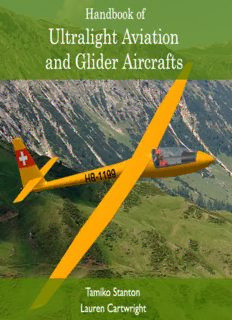
Chapter 7 Glider Aircraft PDF
Preview Chapter 7 Glider Aircraft
Revised Edition: 2016 ISBN 978-1-280-13755-6 © All rights reserved. Published by: College Publishing House 48 West 48 Street, Suite 1116, New York, NY 10036, United States Email: [email protected] Table of Contents Chapter 1 - Introduction to Ultralight Aviation Chapter 2 - Australian Ultralight Aircrafts Chapter 3 - Canadian Ultralight Aircrafts Chapter 4 - Czech Republic Ultralight Aircrafts Chapter 5 - French Ultralight Aircrafts Chapter 6 - New Zealand Ultralight Aircrafts Chapter 7 - Glider Aircraft WT Chapter 8 - Glider (sailplane) Chapter 9 - Radio-controlled Glider Chapter 10 - Airspeed Horsa Chapter 11 - Aeronca L-3 and Military Glider Chapter 12 - Politechnika Warszawska PW-5, Slingsby T.21 and Schweizer X-26 Frigate Chapter 13 - Powered Hang Glider ____________________WORLD TECHNOLOGIES____________________ Chapter 1 Introduction to Ultralight Aviation WT Huntair Pathfinder Mark 1 ultralight The term "ultralight aviation" refers to light-weight, 1- or 2-person airplanes. During the late 1970s and early 1980s, many people sought to fly affordably. As a result, many aviation authorities set up definitions of lightweight, slow-flying aeroplanes that could be subject to minimum regulation. The resulting aeroplanes are commonly called ultralight or microlight, although the weight and speed limits differ from country to country. There is also an allowance of another 10% on Maximum Take Off Weight for seaplanes and amphibians, and some countries (such as Germany and France) also allow another 5% for installation of a ballistic parachute. ____________________WORLD TECHNOLOGIES____________________ The safety regulations used to approve microlights vary between countries, the strictest being in the United Kingdom, Italy, Sweden and Germany, while they are almost non- existent in France and the United States. The disparity between regulations can be a barrier to international trade and overflight in strict regions, as is the fact that these regulations are invariably sub-ICAO, which means that they are not internationally recognised. In most affluent countries, microlights or ultralights now account for a significant portion of the civil aircraft fleet. For instance in Canada in October 2010, the ultralight fleet made up 19% of the total civil aircraft registered. In other countries that do not register ultralights, like the United States, it is unknown what proportion of the total fleet they make up. In countries where there is no specific extra regulation, ultralights are considered regular aircraft and subject to certification requirements for both aircraft and pilot. Ultralight aircraft are generally called microlight aircraft in the UK and New Zealand, and ULMs in France and Italy. Some countries differentiate between weight shift and 3- axis aircraft, calling the former microlight and the latter ultralight. WT The U.S. light-sport aircraft is similar to the UK and NZ Microlight in definition and licensing requirement, the U.S. 'Ultralight' being in a class of its own. Definitions Australia In Australia Recreational Aircraft fall under many categories, but the most common category imposes: • a maximum take off weight (MTOW) of 544 kg or less (614 kg for a seaplane); • a stalling speed under 45 knots in landing configuration and • a maximum of two seats. A new certification category for Light Sport Aircraft came into effect on 7 January 2006. This category does not replace the previous categories, but creates a new category with the following characteristics: • A maximum takeoff weight of 600 kg or 650 kg for an aircraft intended and configured for operation on water or 560 kg for a lighter-than-air aircraft. • A maximum stall speed in the landing configuration (Vso) of 45 knots CAS. • Maximum of two occupants, including the pilot. • A fixed landing gear. A glider may have retractable landing gear. (For an aircraft intended for operation on water, a fixed or repositionable landing gear) • A single, non-turbine engine fitted with a propeller. • A non-pressurised cabin. ____________________WORLD TECHNOLOGIES____________________ • If the aircraft is a glider a maximum never exceed speed (Vne) of 135 knots CAS In either of the above categories, there are distinctions between factory manufactured and home built aircraft. In Australia, microlight aircraft are defined as one or two seat weight-shift aircraft, with a maximum takeoff weight of 450 kg, as set out by the Civil Aviation Safety Authority. In Australia microlights are also referred to as trikes and are distinguished from three-axis aircraft, of which the smallest are known as ultralights. In Australia, microlight aircraft and their pilots can either be registered with the Hang Gliding Federation of Australia (HGFA) or Recreational Aviation Australia (RA Aus). In all cases, except for privately built single-place ultralight aeroplanes, microlight aircraft or trikes are regulated by the Civil Aviation Regulations. WT Pegasus Quantum 145-912 ultralight trike ____________________WORLD TECHNOLOGIES____________________ WT Flight Design CTSW ____________________WORLD TECHNOLOGIES____________________ WT A powered paraglider ____________________WORLD TECHNOLOGIES____________________ WT A US-made Pterodactyl Ascender ultralight on a camping flight ____________________WORLD TECHNOLOGIES____________________ WT Canadian Lazair ultralight covered in clear Mylar Aeroprakt A-22 Foxbat 3-axis ultralight ____________________WORLD TECHNOLOGIES____________________
Description: